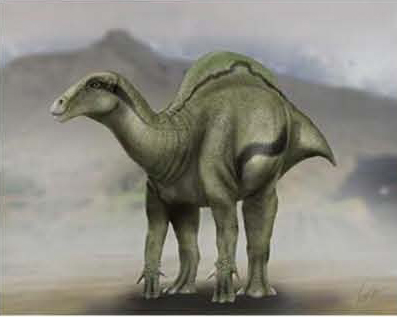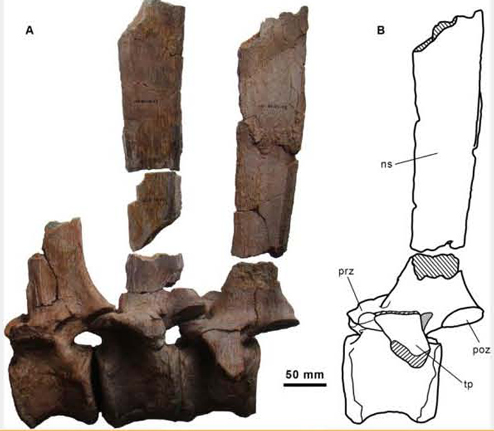Hornless Hualianceratops wucaiwanensis
So, details regarding the dog-sized newest member of the Ceratopsia has been published in the on-line academic journal PLOS One. Say hello to Hualianceratops wucaiwanensis (pronounced as wal-lee-an-sera-tops woo-sigh-wan-en-sis), a small plant-eating dinosaur at the very foot of the dinosaur family tree that would lead to the mighty horned dinosaurs, animals such as Triceratops, Styracosaurus and Pachyrhinosaurus.
New Horned Dinosaur Without Any Horns
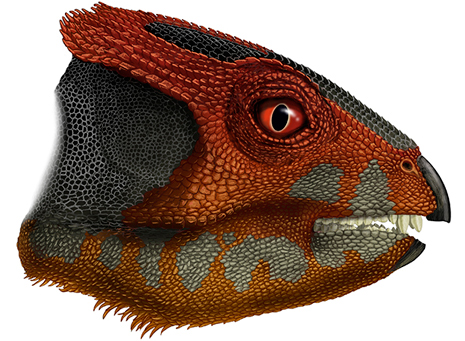
Hualianceratops illustrated.
Picture credit: Portia Sloan Rollings
Ever Expanding Horned Dinosaurs
Over the last ten years or so there have been a remarkable number of new genera of horned dinosaur erected, mostly representing Late Cretaceous ceratopsians from North America. Back in July, for example, Everything Dinosaur team members wrote an article about the latest edition to the centrosaurine group of horned dinosaurs Wendiceratops (W. pinhornensis). The month before that, the other great subfamily of the ceratopsians, the chasmosaurines got a new member (Regaliceratops peterhewsi). Whilst there is undoubtedly lots of attention focused on the six-metre-plus, very ornate giants of North America, palaeontologists, as yet, don’t really understand how the horned dinosaurs evolved, or indeed, little is known about the phylogenetic relationships of some of the earliest forms.
Hualianceratops
Step into the frame Hualianceratops (the name translates as “ornamental face”), here’s a half-metre-long dinosaur that may shed some much needed light on ceratopsian ancestry. Ironically, Hualianceratops manages to hint at future fossil discoveries without providing a great deal of data about itself.
To read the article on Wendiceratops pinhornensis: Southern Alberta’s Wendiceratops.
To read an article describing the discovery of Regaliceratops: New Horned Dinosaur Causes a Royal Rumble.
The angular and the dentary (bones that form the lower jaw along with the predentary) have a roughened texture (rugose). It is this rough texturing not known in any other basal Asian ceratopsian that gives this little dinosaur its genus name. The species or trivial name comes from the Chinese Wucaiwan “five colour bay” from the area in Xinjiang Province where the fossils were found. The strata forms part of the famous Junggar Basin (Shishugou Formation).
Views of the Lower Jaw of Hualianceratops

The mandible of Hualianceratops wucaiwanensis (IVPP V18641).
Picture credit: PLOS One
Roughened Texture
The picture above shows two photographs of part of the lower jaw of this little dinosaur, the angular bone (an) and the dentary (d) have a roughened texture. The fossil material consists of the majority of the skull, plus some fused sacral vertebrae and portions of the lower limbs which include an almost complete left hind leg. It is from these bones that the scientists have been able to deduce that Hualianceratops was a biped, moving around on its back legs, in contrast to the much larger, heavier and later North American ceratopsians such as the famous Triceratops.
Post Cranial Fossil Material (Lower Limbs and Left Foot (Pes)

A partial hind limb and the left foot of Hualianceratops.
Picture credit: PLOS One
The researchers behind the scientific paper, published this week in PLOS One, consist of a team from the University of Washington and from the Institute of Vertebrate Palaeontology and Palaeoanthropology, (IVPP), part of the Chinese Academy of Sciences. These institutes have been collaborating since 2002, exploring numerous fossil sites in north-western China. A number of early ceratopsians have already been named as a result of this research programme. The oldest known member of the horned dinosaur family Yinlong (Yinlong downsi) was found in the same Formation by these researchers. It was formally named and described back in 2006.
An Illustration of Yinlong downsi Earliest Known Ceratopsian
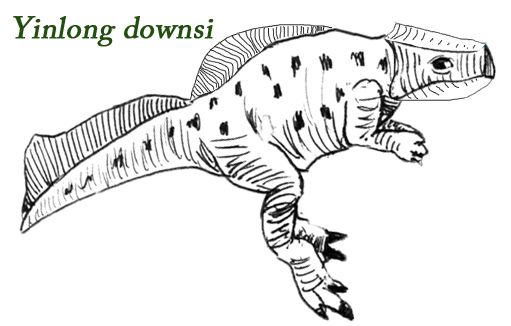
Yinlong downsi, the earliest known ceratopsian dinosaur.
Picture credit: Everything Dinosaur
Hornless Hualianceratops
The newly described Hualianceratops would have looked very similar, but it was slightly shorter and stockier. The bristles are speculative, no evidence of bristle-like structures have been found in association with Yinlong or Hualianceratops fossil material, as far as team members at Everything Dinosaur are aware, but if the related psittacosaurs had such structures it can be speculated that these little dinosaurs also sported similar quills and bristles. Both Yinlong and Hualianceratops, despite being classified as basal horned dinosaurs, did not have any horns.
The genus name Yinlong means “hidden dragon”, this does not reflect any great difficulties of extracting the fossil from the dig site, but merely pays homage to the fact that Xinjiang Province provided most of the location shots for the award winning Chinese film “Crouching Tiger, Hidden Dragon”.
Both Hualianceratops and Yinlong were found in the same fossil bed, although Yinlong’s location suggests that this animal lived before Hualianceratops evolved. The age of the rocks in the Junggar Basin are difficult to date accurately, there is considerable debate as to the precise age of the strata, however, the rock layer from which these two dinosaurs were extracted has been dated to the Oxfordian age (Late Jurassic, approximately 163.5 to 157.3 million years ago).
Greater Diversity of Late Jurassic Horned Dinosaurs
The discovery of a new type of horned dinosaur from Upper Jurassic rocks provides evidence that as early as 160 million years ago, a number of Ceratopsia genera had already evolved. These little hornless horned dinosaurs were much more diverse much earlier in geological time than previously thought.
Commenting on the discovery, Professor Catherine Forster, a biologist at George Washington University and co-author of the scientific paper on Hualianceratops, stated:
“Finding these two species in the same fossil bed reveals there was more diversity there than we previously recognised. It suggests that the ceratopsian dinosaurs already had diversified into at least four lineages [possibly five] by this time in the Jurassic Period.”
Looking for Ghosts
That’s really the significance of these fossil finds, prior to 2006, not a single ceratopsian was known from the beginning of the Late Jurassic. Although, the exact evolutionary path of the Ceratopsia remains unknown and the exact relationship between the likes of Yinlong, Hualianceratops and the closely related Psittacosaurus is unclear, because of these fossil discoveries and similar finds in China, palaeontologists can work out that there must be other early horned dinosaurs awaiting discovery.
Hualianceratops and the Ghosts (Ghost Lineages)
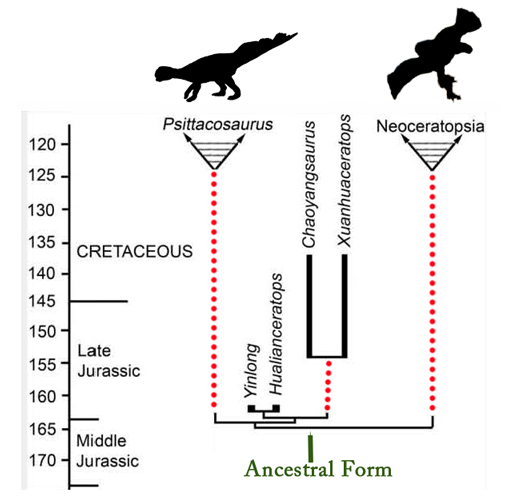
Hualianceratops and the ghost lineages.
Picture credit: PLOS One with additional annotation from Everything Dinosaur
“Ghost Lineages”
Comparing the features of known early horned dinosaur fossils has led scientists to identify a number of “ghost lineages” in the early horned dinosaur family tree. In this instance, when the family tree of these basal ceratopsians is pieced together, the “best fit” that can be made indicates that there are a number of pieces missing. These are ghost lineages, an evolutionary line that has no traces in the fossil record. In simple terms, if the fossils of the “ghosts” have been preserved, then nobody has found them yet.
The researchers conclude that, based on the fossils that have been found at least five ceratopsian lineages were present at the beginning of the Late Jurassic.
- Yinlong
- Hualianceratops
- The ghost lineage that led to the psittacosaurs (dotted red line on the left of the picture)
- A ghost lineage that led to the later horned dinosaurs Chaoyangsaurus and Xuanhuaceratops (middle red dotted line)
- The ghost lineage that led to the evolution of the later Neoceratopsia (the red dotted line on the right)
Potentially, there are more “hidden dragon” fossils waiting to be found. Perhaps, the name for the next basal horned dinosaur to be found from this part of north-western China will be inspired by another film, not “Crouching Tiger, Hidden Dragon” but “Ghostbusters”!
PNSO have created a range of small, model prehistoric animals including several horned dinosaurs. To see this range: PNSO Age of Dinosaurs.


